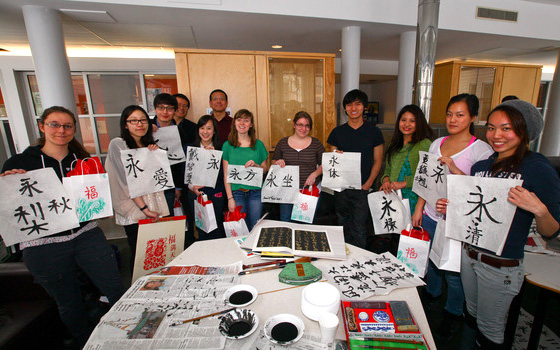Each year Shao-Pin Luo, who runs Dalhousieās Chinese Studies program, plans fun and interactive activities for her students in honour of Chinese New Year.
For this yearās celebration, held on Monday following the official start of the New Year, she introduced a little competition: a friendly calligraphy showdown amongst the students in her introductory, intermediate, and advanced Chinese (Mandarin) language classes.
Calligraphy is a style of writing in which the style and design of the characters is the central focus, and where characters themselves become a sort of art form. Chinese calligraphy is performed with ink and brushes of varying sizes, typically on rice paper.Ā
The essence of character
The event began with a demonstration by Lei Jiang, who is formally trained as a mechanical engineer in addition to being a skilled calligrapher. Students and faculty gathered in the Fireside Lounge in the McCain Building to watch as Dr. Jiang demonstrated the sitting, walking, and flying styles of calligraphy (named for the differences in the speed and style of the brush strokes).
Afterwards, the students were challenged to practice writing the word, āyong,ā which translates to āforever." The word was chosen because it contains all of the common strokes used in Chinese calligraphy. After nearly 45 minutes of effort, the students submitted their work for consideration to the judges, Dr. Jiang and Kuan Xu from the Department of Economics. The best ten calligraphers in the class were then awarded small prizes for their work.
Dr. Luo says that calligraphy is an important aspect of learning about Chinese culture.
āThe essence of Chinese language is its character formation,ā she explains. āMany characters are pictographsā¦ the sun [ę„] looks like a sun, the moon [ę] looks like a moon, the tree [ęØ] looks like a treeā¦ the characters are just fascinating.ā
āCalligraphy then transcends into an abstract art form,ā she adds.
Dr. Jiang agrees, noting that the significance of calligraphy to Chinese culture is difficult to sum up in just a few words.
āItās very unique,ā he says. āThe most significant difference [between Western and Chinese calligraphy] is that Chinese calligraphy uses a soft brush, it provides a lot more freedom to the artist. You can use that to express your own beliefs or spirit or emotions.ā
Patience and discipline
Becoming an expert calligrapher requires both patience and discipline. Dr. Jiang has been studying calligraphy since he was a young boy in China, and practiced for up to four hours a night as a youth. He has been coming to demonstrate calligraphy to Dr. Luoās students for a number of years.
āI would like more students from the Western world to know about Chinese calligraphy,ā he says.
The students, many of whom were trying calligraphy for the first time, seemed to enjoy the experience.
āIt requires a steady hand,ā laughed Joshua Poole, a third year Biology student taking Introduction to Chinese.
The significance of the art form also wasnāt lost on Ophelia Lai, a third-year student in Management.
āItās very traditional,ā she explains āIt keeps the culture [alive] and keeps everything in perspective.ā

The students show off their calligraphy skills.

